- July 2021: MobiKwik Files DRHP For INR 1,900 Cr IPO
- October 2021: MobiKwik Gets SEBI Nod For IPO
- January 2024: MobiKwik Refiles DRHP, To Raise INR 700 Cr Via Fresh Issue
In just over two years, MobiKwik’s tack has changed. The Delhi NCR-based fintech unicorn refiled the draft red herring prospectus for an initial public offering in the first week of 2024. Two years after its initial bid to go public in 2021, the company has clearly reevaluated what it can hope to get from the public markets.
In 2021, the company had set its sights on raising a substantial INR 1,900 Cr (INR 1,500 Cr from fresh shares and INR 400 Cr from OFS), but this has been reduced by 63% to INR 700 Cr in 2024. And unlike the 2021 DRHP, there’s no offer for sale (OFS) from existing shareholders this time.
Interestingly, the 2021 DRHP was filed after the company experienced more than 18% decline in revenue from FY20, and even though in FY22 and FY23, MobiKwik’s revenues have grown considerably (85% over two fiscal years), the fintech unicorn is eyeing a much more muted public listing.
Founded in 2009 by Bipin Preet Singh and Upasana Taku, MobiKwik itself has evolved from 2021 onwards. It started out as a digital wallet and has broadened into a comprehensive horizontal fintech platform.
Currently boasting over 140 Mn+ users and 3.7 Mn+ merchants, the fintech startup expanded its offerings in 2018 to encompass diverse financial services, including credit, insurance, digital gold, and mutual funds. This expansion was in addition to its existing services such as bill payments, payment gateway services, and digital payment solutions.
MobiKwik’s product strategy is in line with the rest of the fintech ecosystem, but ahead of its potential IPO later this year, the question is whether this is enough to navigate the complexities of the public market. Over the past couple of years, MobiKwik has become a lending-first company, similar to most of the competition, and this itself may not be enough, as analysts point out.
More importantly, there is also the question of how MobiKwik fares against listed fintech companies such as Paytm, which have struggled in the stock market. Let’s dive in to find out.
2021 Vs 2024: A Better Deal For Investors?
In contrast to 2021, when emerging tech stocks lacked reference points, leaving both investors and startups in the dark about pricing, the landscape has significantly changed. With the listings of Paytm, Zomato, Nykaa, and other tech stocks over the past few years, their performances serve as valuable benchmarks.
Experts believe that these stocks provide essential insights for emerging startups as well as investors to take precautionary measures concerning pricing, price bands, IPO size, and more. And many also believe that MobiKwik’s rationalisation of its IPO valuation and pricing would serve its existing shareholders well in the long run.
Till date, MobiKwik has raised close to $180 Mn in equity and debt funding from the likes of Peak XV Partners, Orios Venture Partners, Cisco Investments, NET1, Abu Dhabi Investment Authority, Bajaj Finserv, American Express Ventures among others. The startup joined the unicorn club in October 2021 after some employees exercised ESOPs.
MobiKwik, in many ways, offers products similar to Paytm. Both have wallet services, bill payments, lending, and investments as verticals. And MobiKwik can now draw upon Paytm’s IPO as a reference point, which it seems to have done.
This arguably explains why the company has not exactly pushed for an OFS this time around. Existing shareholders are likely to see better returns from waiting for a few months after the IPO to sell their shares when the stock price has stabilised, rather than jump in at the time of the IPO, when listing gains are not a given.
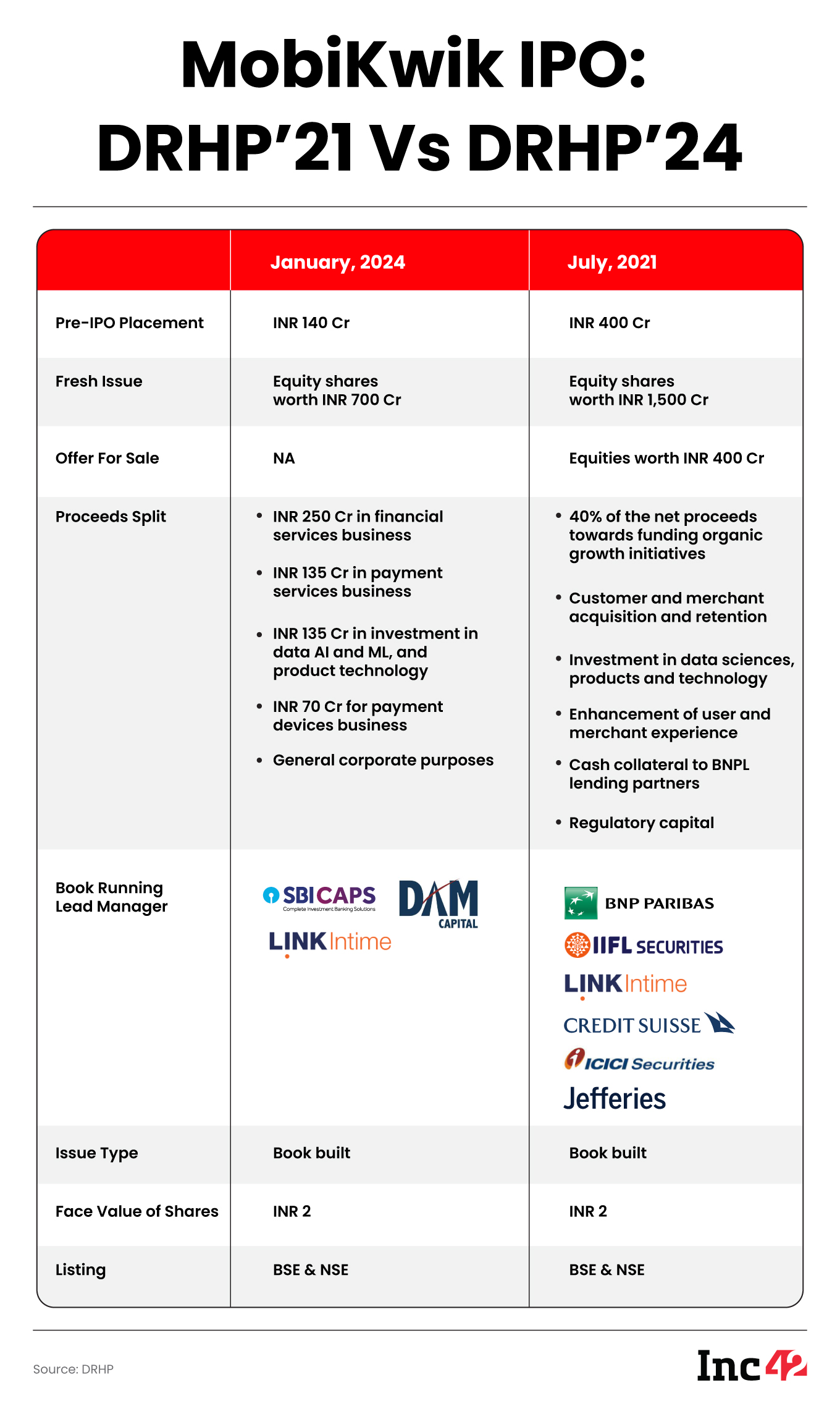

After its listing, for instance, Paytm was criticized for going for a price that benefitted its existing shareholders rather than retail investors, which shook the market’s confidence in the stock. Even in 2024, Paytm has not recovered from the value erosion after listing in 2021.
In line with this, MobiKwik’s valuation and pricing strategy appears to be much more grounded in contrast to 2021. At that time, a bullish sentiment was prevalent among new-age tech companies in relation to public listings. Since then, the experiences of Paytm, Zomato, Nykaa, and others have served as lessons for companies on the IPO path.
As a result, the biggest difference between MobiKwik’s 2021 DRHP and the current one is on the pricing and the valuation it is targeting. The initial higher valuation in 2021, at the peak of the fintech boom, reflected a market flush with capital and high investor enthusiasm for tech startups. The subsequent reduction in IPO size to INR 700 Cr, with a focus on fresh issues, suggests a strategic recalibration in response to a more sober market environment.
“Current market conditions and regulatory landscapes for fintech companies, especially in lending, have necessitated a more grounded approach,” believes Umesh Chandra Paliwal, cofounder and CEO of UnlistedZone.
He added that a smaller IPO size reduces the risk of overvaluation, a challenge that Paytm faced post-IPO when its shares dropped significantly. A smaller IPO size can be more manageable and attractive to investors, especially in a volatile market.
“MobiKwik’s anticipated IPO range of INR 800-INR 900 per share, translating into a valuation of INR 4,500 Cr – INR 5,100 Cr, reflects cautious optimism in the market. Unlike Paytm’s broader product suite, MobiKwik has pivoted significantly towards lending from payments. Lending accounts for over half of its revenue in FY23 and the first six months of FY24,” Paliwal told Inc42.
MobiKwik’s shares in the unlisted market gained by INR 200 in the weeks after its DRHP in 2021, hitting a peak price of INR 1,400 in October 2021. Since then, the stock has slid to a low of INR 350 in the grey market.
Now in early 2024, MobiKwik shares in the grey market are on the rise, but this could be attributed to a potential listing coming soon.
“The drop between 2021 and 2024 indicates the poor perception of MobiKwik among investors. It is potentially seen as a risky investment, likely due to its narrow focus on the highly competitive lending market,” added Paliwal.
The shift from payments or wallets to lending indicates a strategic move to capitalise on India’s growing digital lending market. This is not just the case for MobiKwik but a host of other players in the fintech space.
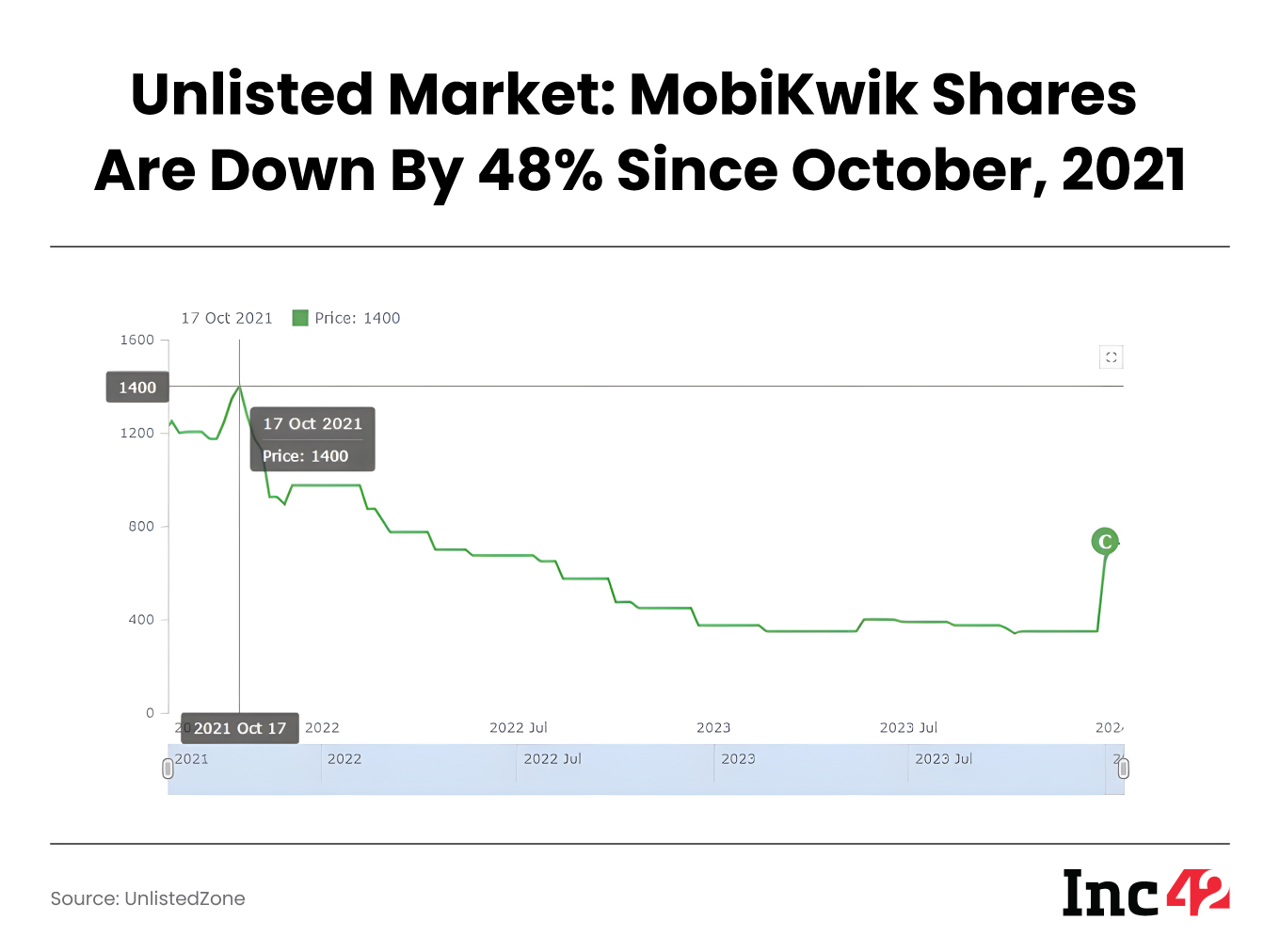

“MobiKwik plans a pre-IPO placement of shares worth around INR 140 Cr. This strategy can help in testing the response of institutional investors and potentially boost investor confidence before the IPO. It also allows the company to reduce the size of the fresh issue if this placement is successful, further mitigating risk,” said Jitesh Agarwal of financial consultancy firm Treelife.
The Short Term Vs Long Term Financials
MobiKwik has recently announced its second consecutive quarter of profitability. The company delivered a strong performance in the first quarter of FY24, achieving an adjusted EBITDA of INR 13.6 Cr, showcasing a significant 181% year-on-year increase.
In Q1 FY24, MobiKwik recorded INR 177 Cr in revenue, indicating a substantial 68% growth compared to Q1 FY23. On a sequential basis, the growth was just over 10% from INR 160 Cr in Q4 FY23. The contribution margin experienced a notable YoY surge of 108%, reaching INR 73.9 Cr between Q1 FY23 and Q1 FY24.
The company’s track record in the past few years has been up and down. In FY21, revenue declined by 18% compared to FY20 as the pandemic disrupted life for many fintech companies.
In FY22, income got a big bump as MobiKwik accelerated its lending business. The company lowered expenditures by relying on the natural demand for credit services during this period, which also closed the profitability gap.
Then, as we can see in FY23, the growth is marginal. To its credit, MobiKwik managed to reduce its expenses in FY23 compared to FY22, resulting in better profitability.
The company is projecting revenue to touch INR 1,100 Cr and net profits to hover around INR 40 Cr – INR 50 Cr in FY24. This would indicate a near 2X growth in the ongoing fiscal year, but much of this will depend on growth from its lending business.
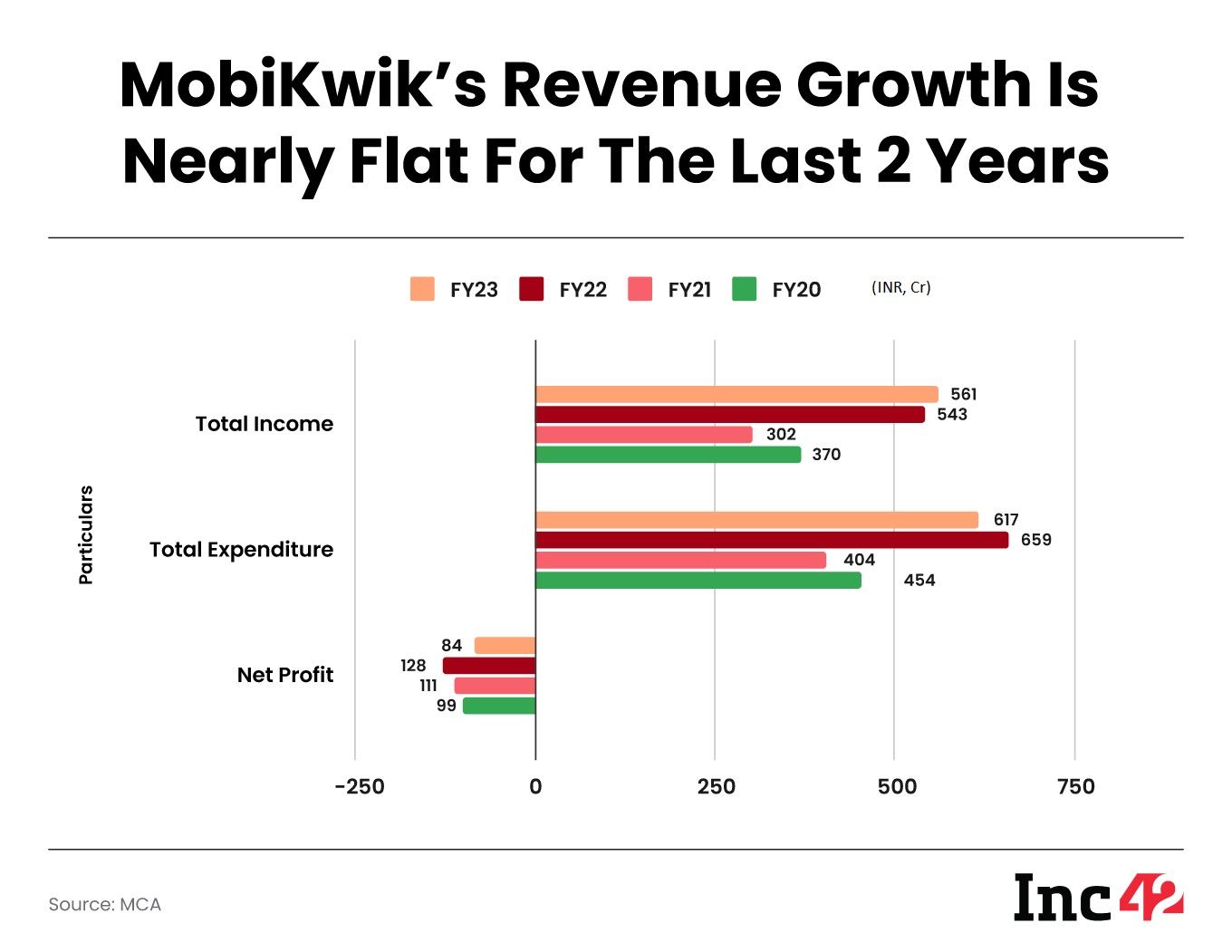

The Shifting Revenue Equation
MobiKwik’s revenue from operations comprises two streams: payment services and financial services.
The former includes revenue derived from merchant fees, and convenience fees charged to consumers for specific categories of services such as bill payments, mobile or DTH recharges. Revenue from financial services is from the lending business.
A bulk of this comes from MobiKwik Zip (credit line), Zip EMI (which offers loans with a longer tenure). Besides this, the company has a P2P investment/lending platform called Xtra.
Interestingly, it was only after the introduction of lending products that MobiKwik’s revenue fortunes turned. In its DRHP, the company said, “We have experienced significant growth in recent years, with our revenue from financial services increasing by 376.52% from INR 60 Cr in Fiscal 2021 to INR 285 Cr in Fiscal 2023.”
More than half of the company’s revenue in FY23 came from financial services. The gross value of loans disbursed has grown nearly 20X in the past two fiscal years. Lending GMV grew at 404.16% from INR 300 Cr in FY21 to INR 1,512 Cr in FY22 and further at 238.24% to INR 5,115 Cr in FY23.
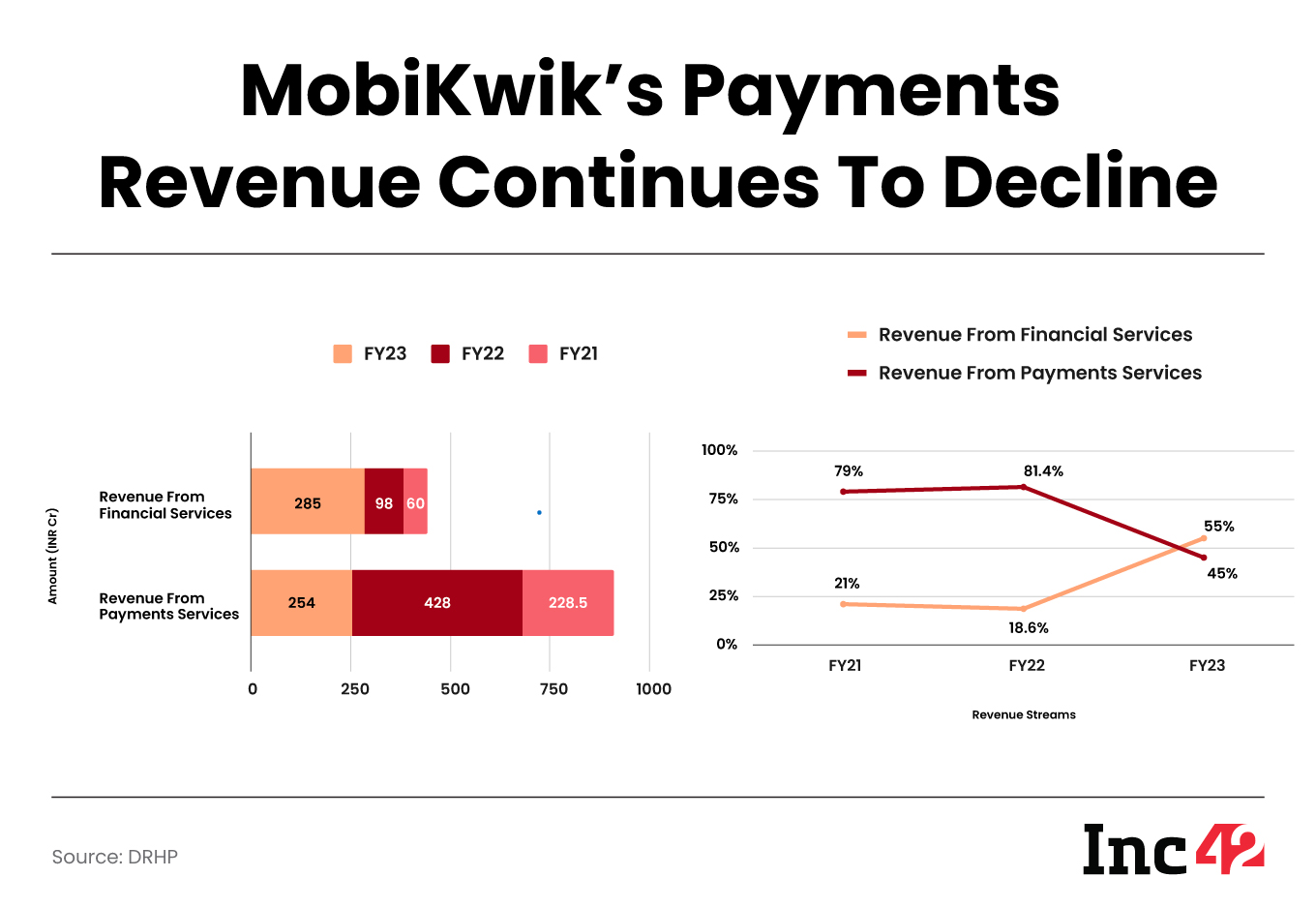

In March 2023, MobiKwik’s initial wallet business only brought in 45% of all revenue for the company, compared to nearly 80% as of March 2021.
This suggests that merchants are increasingly opting out of MobiKwik’s payments gateway and allied services, possibly due to the market dominance of UPI-first competitors such as PhonePe, Google Pay, Paytm and CRED.
“The lending segment faces challenges in valuation due to the small ticket size of the loans on MobiKwik and the tightening of regulations by the RBI in recent months. Any new regulatory changes could significantly impact MobiKwik’s business model,” said Unlisted Zone’s Paliwal.
However, Treelife’s Agarwal believes MobiKwik is on the right track.
Highlighting continued progress towards profitability, showcasing diversification efforts, and demonstrating a clear vision for future growth will be critical to mitigate investor concerns about slow revenue growth and reliance on revenue from lending.
The Market Demands More From MobiKwik
Whether it’s wallet services, bill payments, investments and offering co-branded lending products, MobiKwik is directly competing with PhonePe, Paytm, Amazon Pay, Airtel Payments Bank, and several other fintech platforms. Even the likes of CRED, Groww, BharatPe and others have joined the merchant lending and personal loans market.
MobiKwik has looked to push this with the launch of point-of-sale devices for credit cards, debit cards, wallets, and UPIs. Here, too, there is stiff competition with the likes of Pine Labs and other players also prominent rivals.
In its DRHP, MobiKwik claims it has better capital efficiency on the lending front. But this is not a thesis that has passed the test of time. The fact is that rival platforms have a much larger scale than MobiKwik in terms of consumers and merchants. And over time, this scale will improve capital efficiency for other players.
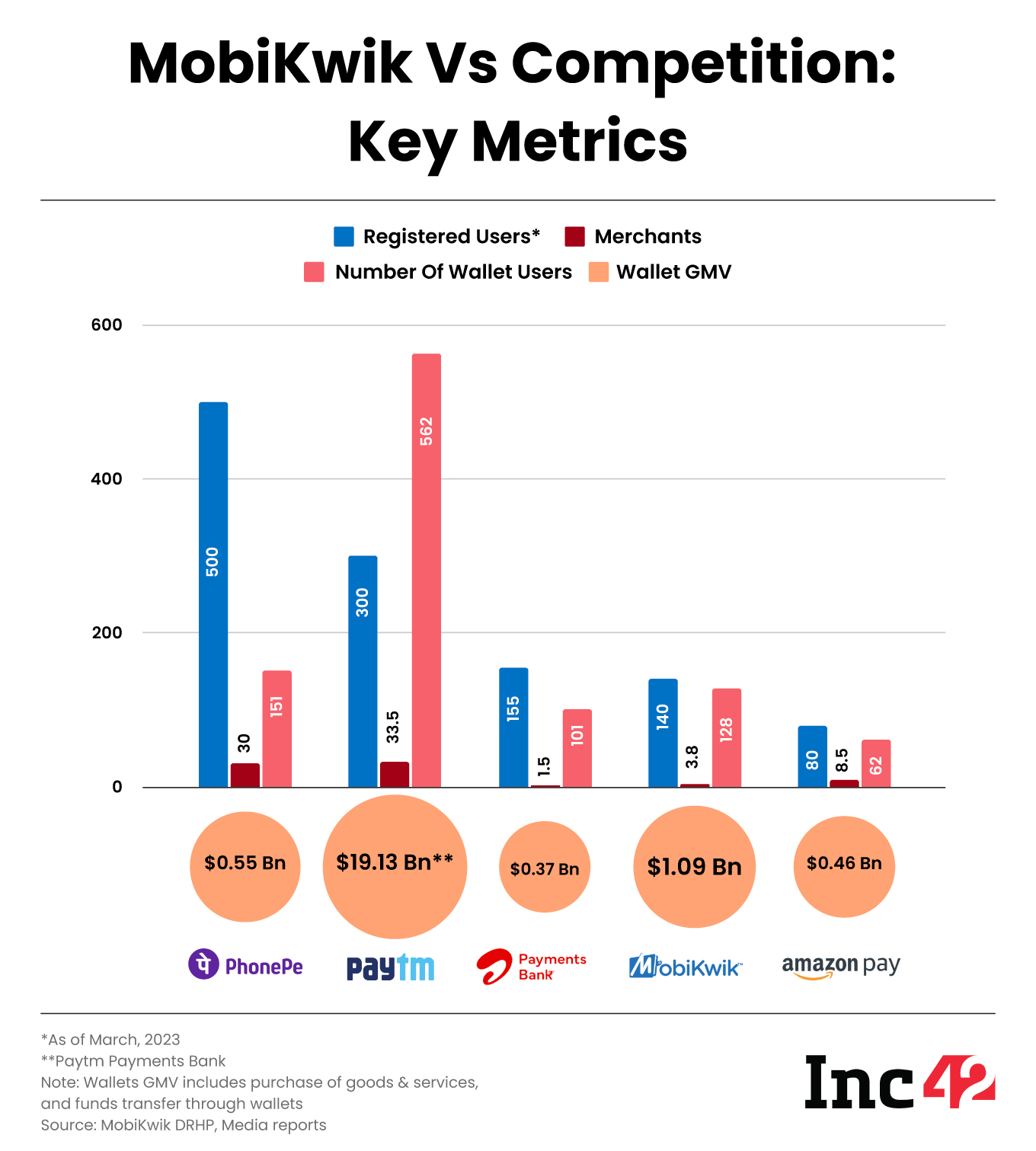

Essentially, the new MobiKwik — the one that has filed the 2024 DRHP — operates in a fiercely competitive sector, where regulatory shifts are rapid, particularly in the business of small-ticket loans that are the primary focus area for digital lenders.
The decline in revenue from payment services also indicates a shift from a product-led approach to growth dependent on the loan book. In that sense, MobiKwik is moving closer to a traditional financial services company rather than a digital wallet.
This dependency on lending would need to be reduced if MobiKwik has to broaden its revenue streams.
Can MobiKwik Add To Lending?
In the short term, investors backing MobiKwik’s IPO are likely to yield reasonable returns, given the favourable current market conditions and the company’s recent profitability.
However, long-term sustainability of the quarterly profits hinges on strategic initiatives such as creating a better product to drive wallet usage, similar to how Paytm has attempted in the past 2-3 years. Acquiring a small finance bank licence would also be critical for companies such as MobiKwik, but these are governed by tight RBI regulations.
Treelife’s Agarwal believes that MobiKwik’s listing could see some gains for initial investors as the IPO size is comparatively smaller than Paytm or other unicorns that went for listings and the fact that the company has managed to report profits.
However, in the long term, MobiKwik needs to consistently work on its product strategy and build a more robust platform that does not depend heavily on lending. Paytm’s example would serve MobiKwik well in the long run. Paytm’s dependency on lending was called into question in late 2023 and the company has seen some shrinkage in a significant portion of the lending business on a quarter-on-quarter basis.
Paytm said it expects more decline in low-ticket size loans over the next two quarters and is currently looking to recalibrate its lending business towards longer tenures and higher ticket sizes. This is expected to take up to Q2 FY25.
Even despite its massive scale, Paytm was forced to rethink its strategy due to changes in regulations or the risk appetite of banks. MobiKwik is also in the same bucket and will need to diversify its revenue sources as soon as possible in the run-up to the IPO and soon after.
MobiKwik has done a lot of hard work in the past couple of years to put its house in order and move towards profitability, but given the competitive fintech market, there is still a lot more work to be done.
[Edited by Nikhil Subramaniam]
